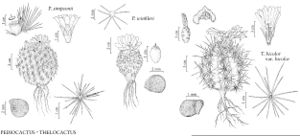Thelocactus bicolor var. bicolor
Plants few branched or unbranched, usually not deep-seated in substrate. Stems usually ovoid to cylindric at maturity, 7.5–18 (–38) × 5–10 (–13) cm, surface very poorly concealed to 1/2 hidden by spines; ribs 8–13, tubercles confluent into rounded ribs 15–25 mm wide; areoles spaced 8–20 mm apart along ribs. Spines red-and-white (older spines weather to ashy white); radial spines 9–18 per areole, longest spines 12–30 mm; adaxial (bladelike) spines 16–75 (–100) × 1.5 mm; central spines (1–) 4, longest spines terete to sharply angular, then abaxially keeled and adaxially flat to grooved, (13–) 20–45 (–60) × 0.4–1.5 mm, adaxial 3 like radials but larger. 2n = 22.
Phenology: Flowering (Feb–May)Jul–Sep.
Habitat: Chihuahuan desert scrub, Tamaulipan thorn scrub, sedimentary, igneous, and alluvial substrates
Elevation: 0-1200[-2000] m
Distribution

Tex., Mexico (Chihuahua), Mexico (Coahuila), Mexico (Durango), Mexico (Nuevo León), Mexico (San Luis Potosí), Mexico (Tamaulipas), Mexico (Zacatecas)
Discussion
Thelocactus bicolor var. bicolor, in the strict sense, may be limited to Mexico; if so, then var. tricolor and/or var. schottii might deserve formal recognition.
Selected References
None.
Lower Taxa
"broad" is not a number.
